Editor's note: This is a transcript of a Starkey live webinar on AudiologyOnline. Download supplemental course materials.
Introduction
Thank you for joining me and taking time out of your day to learn about the Starkey product line. My name is Luis Camacho, and I’m an Audiologist with the Education and Training departments. I'll be your host for today. In addition to talking about the Starkey product line, I will introduce the different product families and highlight the features and tools available to you within the Inspire fitting software. We will also touch on the wireless platform. We will cover a wealth of information today with the hopes that you will find that the Starkey product line has all you need to provide better hearing for your patients.
I want to touch on the different product families and give you some idea of what differentiates the 3 Series from the Wi Series, et cetera. I will also discuss Acoustic Scene Analyzer and noise management tools, Voice iQ2, and frequency lowering with Spectral iQ. We will talk about SoundPoint and our new Xino tinnitus device, assuming that much of this information will be introductory. If we jump into a topic that has a more extensive course available at AudiologyOnline, I will try and remember to point it out to you.
Noise Management
I can guess that the top complaints of your patients are hearing in noise, comfort, clarity, and sound quality. I want to briefly discuss our Acoustic Scene Analyzer. This is an umbrella term we use that incorporates our various noise management approaches and algorithms. These approaches work hand-in-hand at different levels of sophistication within all of the Starkey product families.
As a quick introduction to our noise management, there are three main tools. The first is Voice iQ2, which is our fast-acting noise management system that is geared towards providing maximum comfort and reducing listening effort. Second, we have our InVision directionality, which is our dynamic directional microphone system that improves the signal-to-noise ratio in noisy situations. Third, we have AudioScapes, which is our environmental detection tool to enhance comfort in various listening situations, whether it is those where we want the quietest listening experience possible, outside in the wind, or in high-intensity noise (which we categorize as machine noise). These three things work in conjunction with each other to provide that improvement of comfort and clarity in various listening environments.
Voice iQ2
Voice iQ2 is our fast-acting system. This particular feature is available in the 3 Series, the Xino family, the Wi Series and the X Series products. This is the only noise management algorithm available with clinical data showing that it can reduce the amount of effort the patient has to put forth when listening in difficult, noisy environments.
There is a great deal of flexibility with the Voice iQ2 algorithm. We have the ability to provide up to 20 dB of noise reduction, depending on the technology level and how you set the feature. This is available to you in the all the product families previously listed in the three different technology levels: the 110, 90 and 70 technology levels.
InVision Directionality
The InVision directionality system has the highest directivity index (DI) in the industry, with close to 6 dB DI. We have dynamic, or automatic, switching between directional and omnidirectional modes. The goal is to prioritize speech. One of the great things about Starkey products is that all devices with a directional microphone use this exact same directional system. You will have the highest level directionality regardless of the technology level you are fitting.
AudioScapes
AudioScapes are the three environmental detection systems used to provide maximum comfort to a patient in a particular listening situation. For instance, the quiet algorithm makes sure that we are maintaining the quietest listening experience when there is not any ambient noise. This is our expansion algorithm. We have a machine noise algorithm that is designed for maximum comfort in high-intensity noise situations where speech is not going to be available to the patient. The goal is to make sure that they have a comfortable listening experience and that they do not feel the need to take their hearing aids out.
Next, we have a wind algorithm to reduce the effects of turbulence over the microphones. The sound quality is poor when wind causes a vibration of the microphones. The wind algorithm will bring that down to a level where it is not bothersome to the patient. Again, this is available in all the product families and technology levels. If you would like to get more information on the noise management and noise control features and see it in the software, we do have a course coming up called Noise Control that will dive more into the details of all of these features. Today I wanted to let you know that these user tools are available in the different technology levels to give maximum comfort and clarity.
Binaural Spatial Mapping
Another component of noise control that relates specifically to our wireless products is what we call Binaural Spatial Mapping. With the wireless devices, we now have ability for the two hearing aids to exchange data back and forth between the two devices. I describe Binaural Spatial Mapping as the two hearing aids creating a supercomputer. There is a computer in each hearing aid analyzing the environments. The two hearing aids can talk to each other, make another level of analysis of the environment, and create a three-dimensional sound map around the patient. The hearing aids analyze if the signal is speech, noise, high or low intensity, et cetera. The goal is to have those tools in the acoustic scene analyzer trade information and make sure that the listener is in the best possible setting with the best signal-to-noise ratio. It provides another level of performance with noise management. This is available in the wireless products of the 3 Series and the Wi Series, as well as the new Xino mini wireless receiver-in-the canal (RIC) product.
iQ Boost
Another technology that improves hearing in noise with the wireless products is what we call iQ Boost. iQ Boost is an instantaneous, highly aggressive noise management setting that works in conjunction with either the SurfLink Mobile or the SurfLlink Remote control. When you are programming the hearing aids and configuring either one of these wireless accessories, you can set it so that the star button on either the mobile device or the remote control will activate the iQ Boost setting. When a patient gets into an extremely noisy environment, they press the star button and the hearing aids will change into a directional microphone mode. We automatically increase the Voice iQ2 algorithm to its maximum aggressiveness, and we lower the intensity level required for the Voice iQ2 to hit its maximum level, which is about 20 dB. This is a three-step process that will provide immediate comfort in noisy situations, regardless of the technology level. Even if you are working with an i70 device that does not have as much flexibility with the Voice iQ2, when you activate IQ boost, you give them the most aggressive setting in the Voice iQ2 algorithm.
This is a great tool for patients that might be in transient high-intensity noise situations. For example, I've worked with a patient who works in an auto manufacturing plant. He does not work on the manufacturing floor, but he periodically visits the factory floor. from his quiet office. The iQ Boost was perfect for him when he would leave his quiet office and step on to the factory floor. He would press the star button to decrease the noise to comfortable level, then go back to his quiet office and press the star button again, where things reset back to the original settings. This item is available on the wireless 3 Series, the Wi Series products and the new Xino mini wireless RIC product.
Directionality Plus
Another noise management setting we offer is called Directionality Plus. This is a second stage of aggressiveness. First, you have your default directional setting, then you have Directionality Plus, and then you have the iQ Boost that I just spoke about. With Directionality Plus, any time the directional microphone algorithm detects the need to change to a directional mode, the hearing aid will automatically set Voice iQ2 to the maximum setting possible for that technology level. This will bring down the threshold of that intensity level from 85 dB SPL to 80 dB SPL in order to achieve maximum directionality. There are three stages of aggressiveness with the Voice iQ2, from the default to Directionality Plus and then to iQ Boost. Directionality Plus is available to you on the wireless 3 Series and the new Xino wireless mini RIC.
That is an overview of noise management. Again, I think the number-one complaint from patients is hearing in noise. You can see that we have a lot of different tools there to allow you to fine-tune and personalize for hearing in noise.
Feedback Cancellation
Feedback used to be one of the top complaints of patients with hearing aids. Since the release of our Destiny product line about six years ago, feedback is not much of a concern anymore. With the latest version of our PureWave feedback eliminator, we still have the fastest and most accurate feedback cancellation system in the industry. We have a proven ability to provide up to 28 dB of added stable gain on a completely open fitting. This allows you to have a very stable fitting, regardless of the style of hearing aid or how much power you need. Feedback should not be a main concern any more, even when you are fitting a 70-dB-gain custom RIC product or a 50-dB-gain completely-in-the-canal (CIC). You should have a very stable fitting.
This state-of-the-art, industry-leading feedback cancellation is available to you in almost every technology level: the 110, 90, 70 and 30. They all have the PureWave Feedback Eliminator. It is available in several product families including the 3 Series, Xino, Wi Series, the X Series, Tour and Ignite. You should be able to get a good fit and have very low concern for feedback with today's fittings in the Starkey product.
Frequency Lowering
Another element that was recently introduced last year with the Starkey product line is frequency-lowering technology, called Spectral iQ. There are a number of different approaches to lowering high frequencies. Many of us work with high-frequency hearing loss in patients with probable dead regions where providing clarity and speech understanding can become more difficult. With Spectral iQ, we are taking a very different approach. We are continuing to provide as much high-frequency gain as possible from the hearing aid while simultaneously taking high-frequency sounds and replicating them in a lower-frequency region. The ability to hear and understand speech with this approach is very good.
You can see some very basic, introductory clinical data (Figure 1) that we obtained from a study we conducted with patients who had classic ski-slope hearing loss. You can see that with Spectral iQ off, patients had the ability to understand a little over 75% of what was being presented to them. When we turn Spectral iQ on to the preferred settings in the software, those scores jumped up to over 87%. We pushed it to the extreme and set Spectral iQ to its maximum aggressiveness, where you can see that patients achieved close to 94% correct. This has been a very successful addition to our feature offerings. Spectral iQ is a great tool for providing additional clarity and speech understanding for patients with high-frequency hearing loss.
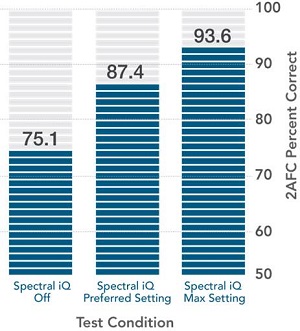
Figure 1. Results from Starkey Spectral iQ clinical data.
To give an idea of how it's working, you can see the visual graphic in Figure 2. The color bar represents low to high frequencies, with the purple-pink out to the far right being the highest frequencies. With higher-pitched soft consonant sounds, such as /s/ and /sh/, we continue to provide the amplification using the normal process out into the highs, but we also simultaneously reproduce those in real time in a lower frequency region, therefore giving a patient access to greater information that they can then translate into speech understanding.

Figure 2. Spectral iQ color graphic, showing the high frequencies in purple and pink being moved to a lower region in green and light blue.
We do have a full-hour course available at AudiologyOnline about Spectral iQ. This is a recorded course which goes into much greater detail than we have time for today. We also have a dedicated website, spectralIQ.com, where you can look at white papers clinical data. You can also listen to how it sounds with the algorithm off versus the algorithm on. Spectral iQ is available in all of the technology levels, from the flagship levels all the way down to the economy products, Tour and Ignite. This is a feature that is available to patients, regardless of how much they can afford or their degree of hearing loss.
Wireless Solutions
Wireless is another realm of technology and offers another level of flexibility and connectivity for your patients. Since the introduction of the Wi Series products three years ago, we have had tremendous success with our wireless platform and SurfLink accessories. Our goal with the wireless IRIS Technology and the SurfLink accessories has been to provide you and your patients with a 100% wireless solution. Let's try and get rid of the need for the patient to wear something around their neck at all times. We also have a 100% wireless programmer, which means that there is no need for the patient to wear anything around his neck during in-office programming, either. The programming range is quite large, as well. Your patients can walk out of the fitting room to provide a truly flexible programming situation.
SurfLink
There are three different configurations of the SurfLink wireless device (Figure 3). First is the SurfLink media device. This is a plug-and-play and home-based media connectivity. They can plug it into their TV, turn it on, and not have to think about it ever again. You can set it up for automatic connectivity. When the patient walks within a certain range of the device, they are connected immediately to their television or computer. There is no need to wear anything on the body for this streaming capability. It is streaming in real-time, in full stereo. It is a great permanent home solution for media viewing and listening.
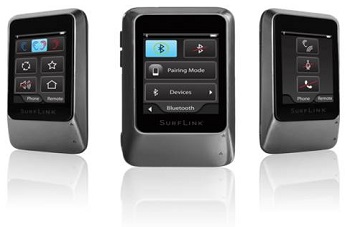
Figure 3. SurfLink wireless devices.
We offer the SurfLink remote control, which is the perfect solution if someone wants a simple remote control. This can be configured in three different ways. You can have a basic remote that turns the volume up or down. You can have it as an intermediate remote that adds a memory rotation and a mute button, or you can go to an advanced remote control that adds in that star button that can be utilized to interact with the SurfLink media or use the iQ Boost that we spoke about. The SurfLink remote offers all three configurations in the same remote control. You simply snap off the faceplate and snap on whichever configuration you want.
Lastly, we have our SurfLink mobile. This is our do-it-all device that was introduced last summer. It will provide maximum connectivity, maximum flexibility and an improvement of hearing for your patients in the widest range of situations. It can function as your phone connectivity for cell phone or Bluetooth-enabled landline phones, along with our Just Talk mode, where the patient does not need to hold anything at all. We are using the hearing aid microphones to pick up the voice. It also has remote microphones built into it. It is truly hands-free that way. It can function for media streaming. SurfLink mobile, of course, also functions as a remote control. This can function as an assistive listening device, whether it's in omnidirectional or directional mode. It is one device that does anything that the patient wants it to do. It can be paired to up to seven different Bluetooth devices. It is a fantastic tool for maximum connectivity, improving hearing in noise, and hearing on the phone.
Again, we have a full AudiologyOnline course on the wireless IRIS technology. This is available to you as a recorded course here at AudiologyOnline, and we do also have a full-hour course just on the SurfLink mobile. That is recorded here at AO as well. If you are interested in more details on the development of our wireless platform as well as the development of the SurfLink mobile device, take a look at those courses.
Invisible Solutions
Shifting gears a little bit, we will talk about a category of products that we call invisible solutions. Along with the desire for better hearing, more and more patients want to feel comfortable with what they are wearing from a cosmetic point of view. That is why we have a wide range of invisible solutions. Our most cosmetically appealing devices offer advanced technology as well. We can break this down into three different categories.
SoundLens
First is our SoundLens device (Figure 4). Starkey introduced and created the invisible-in-canal (IIC) product line. This particular category of hearing aid never existed until about two years ago when we introduced the IIC product, which we call SoundLens. This is available in three technology levels now: 11, 9, and 7. You can now meet the financial needs of budget-conscious patients who want a small custom-fit invisible device with the technologies available in flagship digital devices.

Figure 4. SoundLens IIC device.
We also have our Xino 10A RIC product (Figure 5). It is the smallest, fully-featured RIC product available. If you have a patient, whose ear canal anatomy will not allow him to wear a SoundLens, you can still fit him with a very cosmetically-appealing RIC, such as the Xino 10A RIC. It is amazing how small this can be, yet still have a telecoil, configurable user control, et cetera. This is the tiniest RIC you are going to be able to get.
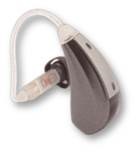
Figure 5. Xino 10A RIC product.
On the other end of the spectrum, we have our AMP device (Figure 6). This is designed to be a stock CIC product that will appeal to a different clientele, perhaps to patients that do not think they need hearing aids. It is an easy-to-fit digital device designed as the starter hearing aid. You can pull it off the shelf, pop a battery in it, find the right size sleeve, and slip it in the ear. It has a great sound quality considering the size. We do have a full-hour course available on AudiologyOnline covering invisible solutions and rationale of deep fit.
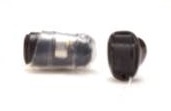
Figure 6. AMP stock invisible CIC.
Starkey Pediatrics
A lot of people do not think of Starkey as a pediatric company, but we do have a full pediatric product line with colors that are going to appeal to your pediatric patients. We are the only company that has a partnership with Nickelodeon. We have the ability to provide educational materials that will appeal to the pediatric patient with characters like Dora, SpongeBob and iCarly. You can even put these characters in your patients’ earmolds. We have a full earmold lab, which allows us to do virtually anything needed for pediatric patients’ earmolds. In fact, if you purchase a device for a pediatric patient along with the earmolds, they will get one year of free earmold remakes. This is a benefit to add needed flexibility for pediatric patients over the lifespan of their hearing aids and earmolds.
We have a pediatric mobile app that goes through education. It lets the patient build and design their own earmold. If you are working with children and have not thought about Starkey as the pediatric supplier, take a look at us again. I think you will see that we have a lot to offer.
A hate to sound like a broken record, but we have a full-hour course on Starkey pediatrics and our approach to the pediatric patient within the software. You can look at that if you want more detail on our pediatric program.
Professional and Patient Tools
We have just covered some big topics. Those are the things with which you will be working and manipulating on a day-to-day basis to provide better hearing to your patients. What other things can we offer you to reach that goal? We want to give you all the latest tools and a variety of ways to engage with your patients to go from the beginning of the patient journey all the way through the end. When we talk about the patient journey, we include that pre-fitting stage, when you are doing a hearing test and counseling on the hearing loss, all the way through the fitting stage and the post-fitting stage. You want to have a variety of tools in your toolbox that you can pull out any time you need to make sure that you can meet the needs of your patient.
Hearing Loss Simulator
One of the things within the Inspire software that is great for this is our hearing loss simulator. The hearing loss simulator is part of the counseling tools. With this, you have the ability to counsel the patient and families on the effects of hearing loss in a very engaging and visual manner. You can show the audiogram and demonstrate everyday sounds and speech sounds. You can put up graphical representations showing where everyday sounds occur. If you have a third party there, you have the ability to play audio files that are filtered for their loved ones’ hearing loss. They can experience what their husband or wife hears when the phone rings, when someone is speaking to them, or when there is noise in the environment. It is a great way to pull in that third party and engage them to realize the effects that hearing loss has on their loved one.
Lifestyle Solutions
The Lifestyle Solutions counseling tool is a standardized protocol to engage the patient in the process of identifying the technology that is appropriate for them. They can be involved in the process of identifying the various environments in which they need help. They can jump in and take a look at the styles, colors and accessories, all of which builds up to a final recommendation. There is a report that can be printed out for the patient. It is all about engagement and allowing the patient to be part of the whole process. It helps them come to the point of saying they need help hearing. Both the hearing loss simulator and the Lifestyle Solutions are also available as an application for the iPad. These portable tools can be used in the nursing home or in the waiting room and counseling areas. You are not tied to your computer anymore.
Experience Manager
The new 2013 software contains updates to our Experience Manager, which is particularly helpful when you are working with a patient that needs to be eased into the amplification process. We now have more distinct changes between the different experience levels (experienced, familiar, inexperienced), and we also have a brand-new transition level. It is specifically designed for when you are working with a patient that has maybe been wearing another manufacturer’s hearing aid for a while and has gotten used to that particular sound quality. You are moving them into a Starkey product. You can start them off with something a little closer to what they are used to with the end goal of having them transition from the initial level up to a level 1, then to a 2, and finally, a level 3 where we are hitting the prescribed gain needs for that patient. This is an example of how we constantly evolve the tools available to you.
Swap Fit
Swap Fit is a tool that helps transition someone from an older-technology Starkey product into a newer-technology Starkey product. Maybe they have been wearing a Wi Series for three or four years, and they are going into a new Xino wireless. You have that ability to take the settings from their old technology and transfer them into the new technology so that they can start at a familiar point and gradually change the settings over time. Ultimately, they will have even better hearing than what they had before, which is the goal of a new hearing aid for patients at all times.
Speech Mapping
The speech mapping tool within the Inspire software is an example of something that is going to be used for a variety of different purposes. This is a great tool for verifying audibility. It can be used for troubleshooting. The sky is the limit of what you can do with the speech mapping tool. It is embedded within the software, which is a great feature. You can open it up when and where you need it during your fitting process and have added visuals to help you in your counseling, troubleshooting and your adjustment processes. You do not have to worry about going to another computer or opening up another software. It is there and ready to be used at all times.
SoundPoint
SoundPoint is something that we have been talking about now for about two years. I wish it was utilized more, and I am hoping that the more we talk about it, the more people are going to realize it is a fantastic tool. SoundPoint can not only improve the fitting but improve the level of satisfaction with the patient's hearing aids. This gives your patient the ability to become an active partner in the adjustment process. Let them make some very subtle, fine-tuned adjustments to their own hearing aids based on their own listening experience in your office and select the best sound quality for themselves. SoundPoint is available in 110, 90, and 70 technology levels of the 3 Series, the Xino, the Wi Series, and the X Series devices. You can run it directly from your computer desktop or use an iPad and a Wi-Fi network in your office if you want a different type of interface. If you have heard about it but have not tried it yet, take another look, because it opens the door to another level of engagement and satisfaction with your patients.
Independent Speech Optimization
Because we want to enhance and provide better hearing for your patients, we are always looking to improve what we have within our products. The Independent Speech Optimization compression architecture is a great example of this. This is available to you on the 3 Series, the Xino wireless and the Tour devices. It lets you fine-tune as much as you need based on the gain requirements of the patient. I think one of its best characteristics is that you do not need to think about compression with this particular compression architecture. All you need to know is if the patient needs more or less soft, moderate or loud gain. Based on that input from your patient, you can focus on giving them the sound quality they need and not have to think about what kind of compression ratio or kneepoint they need. Those characteristics take care of themselves. When you focus on the gain needs of the patient and personalize it, the patient is going to walk away with better hearing and a better sound.
Self Learning
Self Learning is another component that is available on devices that have a volume control, including the 3 Series, Xino, Wi Series and X Series. It is turned off by default, but it is available to you if you think it is appropriate for the patient. With the wireless products, you always have synchronized user control capability. On the 3 Series, Xino wireless, Wi Series, Tour and Ignite wireless products, you can set it up so that memory changes or volume control changes are achieved binaurally with an adjustment from just one hearing aid. You have full flexibility with synchronized user adjustments on your wireless devices.
Streaming Memories
Something that we added last fall with more and more use of our wireless accessories is what we call our streaming memory. This is for people who are doing a lot of media streaming or want a specific sound quality when they are utilizing their SurfLink Mobile on the phone. You can now put in a dedicated streaming memory that provides a robust sound quality when they are listening to the television or music or talking on the telephone. This is particularly useful with those open fits where you are letting normal low frequencies go in and out of the earbud or the earmold. Not providing any amplification there can lead to a tinny sound quality if you are not using a streaming memory with the phone or media device. If you have someone who wants a specific sound quality in those settings, take a look at the streaming memory that is available to you in the wireless product.
Telecoil or TeleLoop settings are becoming more common. Looping rooms, homes and businesses is becoming more popular all around the country. We have a built-in telecoil loop memory for any device that has a telecoil. It gives an automatic 12 dB boost to the telecoil setting, making it more appropriate for those looped environments.
At Starkey, we have tried to think of everything that is going to provide you and your patients some personalization. Demonstrating hearing aids in the office is a great way to illustrate the benefits of technology. One way to do this is with our Xperia products. These are one-size-fits-all or stock wireless devices. They are designed to look and fit like a custom product, but they are stock devices. They use three different earbud sizes and are fully wireless. This is flagship-level Wi Series technology, compatible with all of our of SurfLink accessories. It is a simple way to demonstrate wireless technology to your patients.
Mobile Apps
We have more mobile apps than any other manufacturer in the industry. One of those is our new Hear Coach, which is an auditory training application. Mobile applications, I believe, are going to become more and more important because your patients will want to have connectivity wherever they are. You want to have the ability to counsel and work with them not just in the fitting room.
Starkey On Demand
That moves us into our Starkey On Demand and Tele-Health areas. With T2 on demand, you have the ability to make adjustments to the patient's hearing aids over the phone. Our Audiology On Demand Tele-Health support can be on the phone and online live with you while you are working with the patient in your office. We want to open the door to connectivity, not just with you and your patients, but also between Starkey and you.
Product Spotlight
Let's spotlight some of the product families. We are going to run through each one of these and highlight what is available to them. When we are talking about technology levels, we like to break it down into lifestyle: Basic, Calm, Social, Active, and Vibrant (Figure 7). You can divide this up by technology level (i20, i30, i70, i90, and i110), as well as by channels, from 4 to 6, 8, 12, and 16. Anytime you see an “i” in front of the number that means it is a wireless technology.
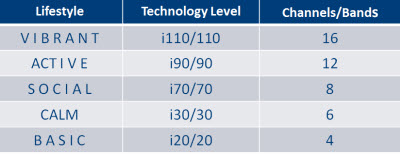
Figure 7. Lifestyles and levels.
The Basic level is 20 or i20. In Figure 8 you can see the sentence, “I should go see my doctor soon.” A visual analogy up at the top is how someone with normal hearing hears this sentence. Down at the bottom is how a person with a hearing loss would hear that without hearing aids. You can see it is much more difficult to read that visual analogy of what the hearing loss is like in vision.
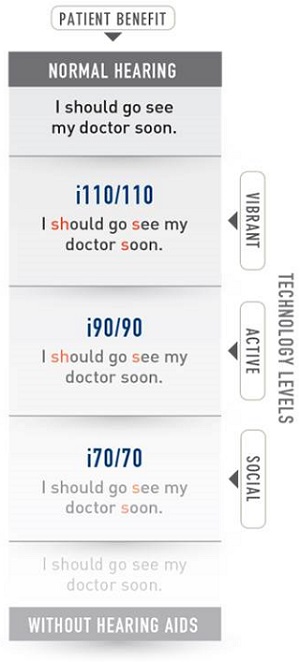
Figure 8. Starkey patient benefit at each technology level. As an analogy, the easier it is to see and read the phrase, the easier it is to hear the phrase.
We move next to the Social technology level. You can see it is starting to become a little bit easier to read (Figure 8). You can see the “S” there in red because we now have Spectral iQ turned on. We go up to the i90 or Active level. It is becoming a little bit easier to read, again, because we have more flexibility with noise management. All the way up at the top are the flagship 110 products. These are even better because we have maximum noise control features and Spectral iQ features. It is never as good as normal hearing, but it is as close as you can possibly get.
3 Series
Let's take a look at the 3 Series (Figure 9). With the 3 Series, you have a 312 RIC and a 312 BTE. Both have a rocker switch so that the patient can easily find it for manipulation of the controls. You have this in the i70, i90, and i110, both in wired or wireless capabilities. With your RIC products, you have 50, 60, or 70 dB gain receivers, directionality, full wireless connectivity and Independent Speech Optimization. With the 3 Series RIC product, we have what we call our Snap Fit receiver. This is a simple-to-connect-and-disconnect receiver cable. It has a pin connection that is very secure, highly water resistant, and easy for you to change in the office if you need. We are now introducing our 3 Series 13 BTE. It has the same features and the same rocker switch, just with a size 13 battery. If a patient needs a longer battery life than what the 312 offers, they have that with the 13 battery. This is available in the i110, i90, and i70 technology levels. We are expanding that 3 Series product family to now include the 13 BTE as well.
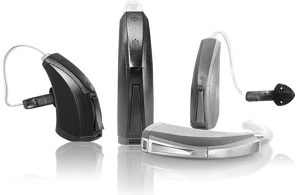
Figure 9. 3 Series product family.
Figure 10 shows a rundown of the standard features. Anything you would need in a product, you have it in the 3 Series, including acoustic scene analyzer, Spectral iQ, Self Learning, Autocoil, Independent Speech Optimization, et cetera. If you need it, we have it for you in the 3 Series. For the wireless products, you have full wireless connectivity with all of the accessories possible.
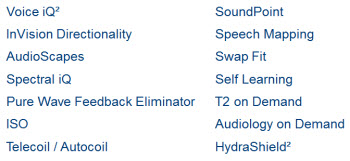
Figure 10. 3 Series standard features.
Tour
The Tour (Figure 11) is an entry-level product family that has the same physical form factor of the 3 Series. You have the same 312 RIC and BTE, but in the i20 and i30 technology levels. These are for those Basic and Calm lifestyles. They have of 50, 60, and 70 dB gain receivers in a 4 and 6-channel instrument. There are many great standard features, including Spectral iQ, Invision Directionality, and the Independent Speech Optimization compression architecture.
This is a fantastic entry-level product for your patients who need that particular price point and desire some of the manual features like a rocker switch. It is a great product family. The wireless Tour products provide full wireless connectivity. Any wireless product from Starkey works the same when it comes to wireless programming, media connectivity, SurfLink Mobile, and remote controls. You have access to the wireless IRIS Technology, regardless of the technology level of the hearing instrument.
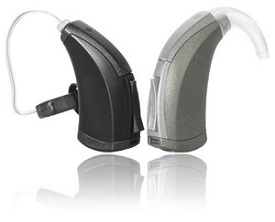
Figure 11. Tour product family.
Xino
The Xino product family (Figure 12) has expanded with the January 2013 launch, as well. We started off with the Xino 10A RIC, which is the smallest fully-featured RIC product in the industry. We are now introducing the new Xino wireless. This is a 312 battery wireless product. It has the similar design of the Xino 10A. It is very small and discreet, but it now has fully wireless functionality in the i70, i90, and i110 technologies. It has an easy-to-use volume or memory adjustment switch, with full connectivity to cell phone and media. I think this is a great addition to the Xino family. Of all the RIC products that you have at your disposal, I think the Xino wireless is going to jump to the top of your favorites list very quickly.
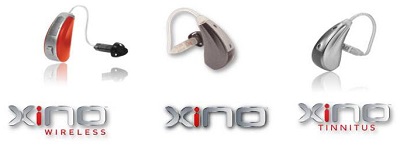
Figure 12. Xino product family, including Xino 10A RIC (middle), Xino wireless (left) and Xino tinnitus (right).
We also have the new Xino tinnitus device. Physically, this looks exactly like the Xino 10A RIC. This comes only in the 90 technology level at this point. If you were to plug it into the software, you would see this is a Xino 90 technology level. It has tinnitus therapy capabilities. You have memory-configurable capabilities with the ability to go in and personalize the tinnitus signal for the patient on a per-memory basis. This is very cosmetically appealing, which can be very important for your tinnitus patients. If you have been looking for something to help your tinnitus patients find relief, take a look at the Xino tinnitus device.
We have two courses already recorded on Xino tinnitus here at AudiologyOnline. We also have a guest speaker, Dr. Richard Tyler out of the University of Iowa, who will be doing courses on counseling and identification of tinnitus patients. If you have been waiting for this from Starkey, it is here now, and we have various methods for you to become educated on this particular device. Visit the Starkey course library on AudiologyOnline to browse these courses and more.
Wi Series
Wi Series contains custom products as well as RIC products (Figure 13). If you are looking for custom wireless devices, the Wi Series is the place to go. You have wireless capabilities from a full shell in-the-ear (ITE), all the way down to the CIC in i70, i90, and i110 technology levels. You have our original RIC 13 and RIC 312 products with 40, 50, 60, and 70 dB gain receivers.
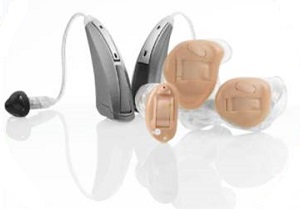
Figure 13. Wi Series product family.
X Series
Next, we have the X Series (Figure14). This is our non-wireless technology product family that ranges from the typical custom products, CIC through ITE, as well as the specialty products including the SoundLens. The X series is available in the 110, 90 and 70 technology levels, as well as power and power plus BTEs with 70 and 80 dB gain receivers, respectively. If you have a patient that needs the most power possible out of a BTE, go to the X Series. That is where you are going to find it.
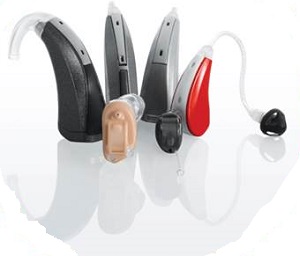
Figure 14. X Series product family.
Ignite
The last product family is Ignite. Ignite is another economy product line, but here you have the ability to fit custom wireless products. If you have someone who only needs an entry-level product but wants wireless connectivity in a CIC or in an ITE, this is where you go for it. You have the i20 and the i30 technology levels. If you are looking for a non-wireless entry-level custom product, you also have those in the 20 and 30 levels here. You also have the original RIC 13 and RIC 312 products as well. The Ignite wireless devices are fully compatible with all of the SurfLink accessories. You do not have to give up any kind wireless connectivity just because you are working with an economy wireless product.
Education and Training
We want to always make sure that you are aware of education and training opportunities. We pride ourselves at Starkey Hearing Technologies for giving you the information that you need, when and where you need it. There are a lot of different opportunities (Figure 15) on the Web, from StarkeyPro.com, StarkeyEvidence.com where we have all of our white papers and research information, spectraliQ.com, Hearing-Aid.com, which is a great site for your patients, as well as Inspire Online, or Quick TIPS. Of course, there are live and recorded courses here at AudiologyOnline as well. Some of you may be surprised to know that we have a YouTube channel where you can see podcasts and other information about Starkey. We want to continue to lead the way and provide you with the greatest connectivity in the same way you are providing your patients with the greatest connectivity.

Figure 15. Educational opportunities from Starkey.
I know that was a lot of information. I hope you are going away knowing that we have several product families and technology levels to satisfy any patient that walks through the door. We have the tools and the features to provide your patients with the best hearing experience possible. If there was a particular topic on which you would like more information, take a look at here at AudiologyOnline. Most likely, we have a full-hour presentation on that particular subject. Thank you for your time and attention.
Cite this content as:
Camacho, L. F. (2013, March). Starkey products: better hearing. AudiologyOnline, Article #11680. Retrieved from: www.audiologyonline.com/


